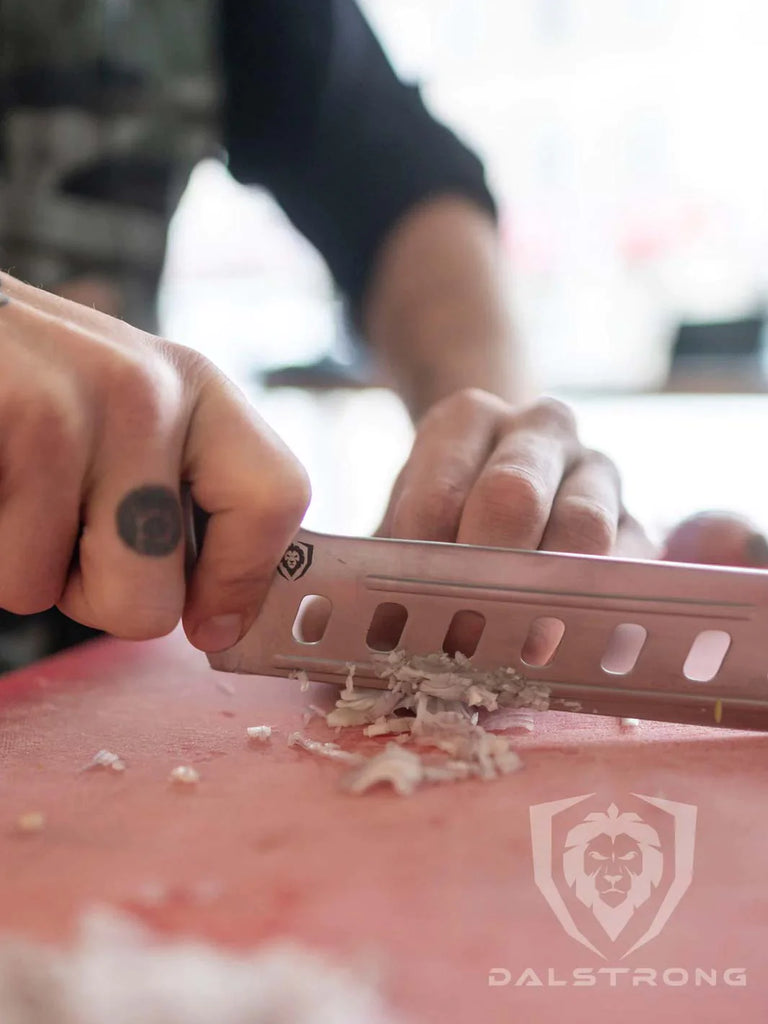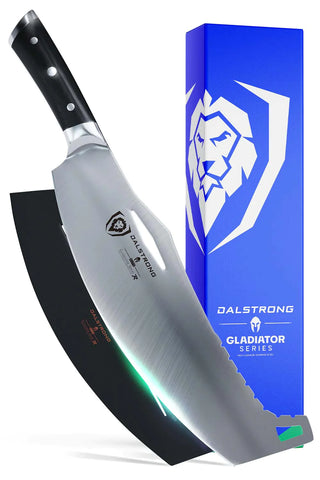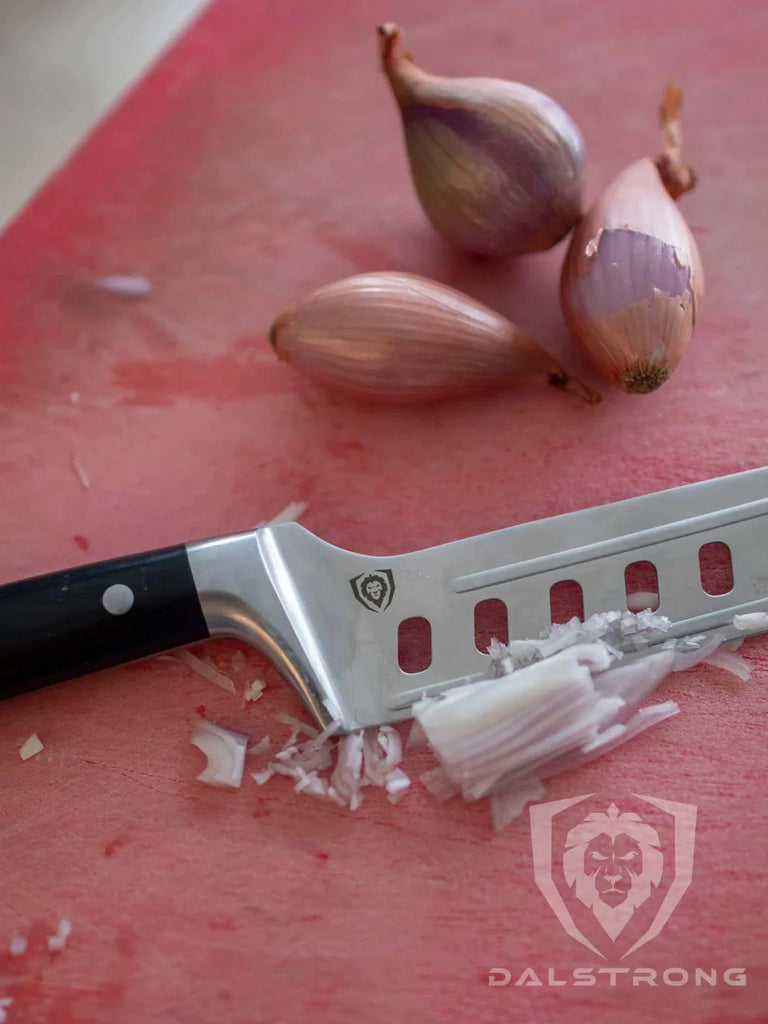 Gladiator Series Nakiri Asian Vegetable Knife 6"
Gladiator Series Nakiri Asian Vegetable Knife 6"
Welcome to the flavorful world of mincing! In this blog, we'll unravel the art of finely chopping ingredients, exploring the nuances of this culinary technique. From creating closely bonded mixtures with a firmer texture to distributing flavors uniformly, mincing plays a pivotal role in diverse dishes, including Greek cuisine and recipes involving root vegetables. Join us on a journey through the mincing process and let’s dive right into it.
1. What Is The Definition Of Mincing?

Mincing, a culinary technique, is finely chopping ingredients for a closely bonded mixture. It keeps individual chunks, providing a firmer texture in dishes. The goal is to distribute flavor evenly, delivering a true mince effect. In Greek cuisine, root vegetables often undergo mincing for recipes.
Using a chef's knife or food processor, this method requires careful chopping or dicing. It's an essential skill, especially when cooking with advanced techniques and exploring diverse recipes.
2. Why & When To Use Mince Cuts?
Mincing cuts are a culinary secret weapon, employed for several reasons in the kitchen. When you desire a closely bonded mixture of ingredients, creating a firmer texture in your dish, mincing comes to the rescue. This technique is perfect for distributing flavors uniformly, ensuring each bite is a delightful blend. Whether you're crafting Greek cuisine or experimenting with root vegetables, mincing proves essential for achieving the desired consistency.
The magic of mincing lies in its ability to delicately chop or dice, maintaining individual chunks while creating a cohesive blend. If you're using a chef's knife or a food processor, the process is versatile and adaptable to various recipes. From creating true mince effects to exploring advanced cooking techniques, the art of mincing elevates your culinary prowess.
So, when should you use mince cuts? Anytime you want to infuse your dish with a finely divided, well-blended mixture of ingredients, and ensure a tasteful adventure in every bite, mincing is your go-to technique. Embrace the mincing magic and unlock a world of culinary possibilities in your kitchen!
3. Different Methods To Mince
Mincing is a versatile culinary technique, and mastering different methods can elevate your cooking skills. Whether you're using a chef's knife, food processor, or exploring advanced cooking techniques, understanding the diverse approaches to mincing is key to creating a range of delicious dishes.
Chef’s Knife
One classic method of mincing involves using a chef's knife. Start by selecting fresh ingredients and ensuring your knife is sharp. For firmer foods like vegetables or herbs, dice them into small, uniform pieces. Hold the knife with a firm grip and use a rocking motion to finely chop the ingredients. This method allows you to maintain control over the size of the mince and is particularly useful for creating textured mixtures.
Read about how to clean a knife the safest way, here.
Food Processor
Another popular tool for mincing is the food processor. This handy appliance simplifies the process, especially when dealing with larger quantities of ingredients. Ensure the food is clean, dry, and cut into manageable pieces before placing it in the processor. Pulse the machine to achieve the desired mince consistency. The food processor is efficient and saves time, making it a preferred choice in many kitchens.
Traditional Methods
Advanced learners often explore techniques beyond traditional chopping. Bruising is one such method that involves gently crushing ingredients to release flavors. While not always associated directly with mincing, bruising can enhance the overall effect, especially when working with herbs or softer items. This method is about delicately breaking down cell walls to unlock the full potential of flavors.
The intention behind mincing can vary based on the desired outcome. When aiming for a closely bonded mixture of ingredients, consider the meticulous process of dicing. This involves cutting food into small, uniform pieces to achieve a cohesive blend. Dicing is commonly used when a recipe calls for a specific texture, ensuring each component contributes to the overall harmony of the dish.
4. Dalstrong Tools To Help You Mince
1. Ulu Rocking Knife 7" Gladiator Series NSF Certified Dalstrong
Experience culinary excellence with Dalstrong's Gladiator Series 7″ Ulu Knife. Crafted from premium 5CR15MOV steel, it ensures precision and durability, making it perfect for conquering kitchen tasks.
PROS:
- Precision-forged edge at 16-18° per side for optimal cutting performance.
- Engineered to withstand extreme heat and cold, ensuring longevity.
- Premium G10 Garolite handle offers strength, shock absorbance, and a glossy finish.
CONS:
- Available in 7" size, this may not suit those seeking varied lengths.
- While easy to clean, occasional sharpening is recommended for prolonged sharpness.
2. Ulu Knife 6.5" Shogun Series ELITE Dalstrong

With a meticulously hand-polished blade and copper mosaic pin, this knife is not just a tool but a masterpiece. The included PerfectFit Dalstrong sheath guarantees protection for your blade. Elevate your culinary journey with the lion in your hands.
PROS:
- Exceptional sharpness and edge retention.
- Military-grade G-10 Garolite handle for durability and heat resistance.
- Meticulously hand-finished blade with an engraved lion head logo.
- Copper mosaic pin adds a touch of distinction.
CONS:
- High initial cost compared to standard kitchen knives.
3. Rocking Herb Knife 7" Gladiator Series NSF Certified Dalstrong

With a satin-finish blade and NSF certification, this knife is as stunning as it is functional. This knife is versatile and can be used for herbs, vegetables, and also meat.
PROS:
- Precision-forged German ThyssenKrupp steel for ultra-sharpness.
- G-10 Garolite handle for durability and ambidextrous use.
- Hand-polished bolster for balance and finger protection.
- NSF Certified (B07M95XSKY) for top-tier quality.
CONS:
- The blade length may be considered a drawback for users seeking a knife with minimal upkeep requirements.
4. Rocking Cleaver Knife 12" Gladiator Series Limited Edition Dalstrong

This versatile giant effortlessly handles herbs, pizzas, kebab meat, and more. Crafted from high-carbon 7CR17MOV steel, the blade offers precision with a Rockwell Hardness of 56. The ergonomic G-10 handle ensures a comfortable grip and lasting durability. NSF certified and featuring a rock-chop design, this knife is a masterful addition to your kitchen arsenal. Unleash its power for culinary creativity and precision.
PROS:
- The 12” blade is designed for various kitchen tasks, from herb mincing to carving meats.
- 7CR17MOV steel ensures durability and a razor-sharp edge with easy maintenance.
- Military-grade, hand-polished handle offers superior control and comfort.
CONS:
- Size may be overwhelming: The 12” size may be too large for users accustomed to smaller knives.
- As a limited edition, availability may be restricted, making it challenging to obtain for some customers.
5. Cleaver Knife 4.5" Shogun Series ELITE Dalstrong
This mini cleaver is not just a tool; it's a masterpiece with an engraved end cap and intricate copper mosaic pin. It's small size is perfect for those who find big cleavers overwhelming.
PROS:
- Hand-sharpened to an acute 8-10 degrees for scalpel-like precision.
- The hand-finished blade boasts a stunning visual pattern.
- Functions as a hybrid between a cleaver and utility knife, handling various cutting tasks.
- AUS-10V super steel core, full tang, and military-grade G-10 handle ensure longevity.
CONS:
- The 4.5" size may be small for users accustomed to larger cleavers.
5. Frequently Asked Questions
What is the meaning of mincing?
The meaning of mincing is to finely divide ingredients, often achieved with a chef's knife or food processor, creating a closely bonded mixture.
What is the meaning of mincing in cooking?
In cooking, mincing refers to the technique of finely chopping or dicing ingredients, ensuring a closely bonded mixture for a firmer texture in the dish.
What is the explanation of mince?
The explanation of mince is the process of finely dividing ingredients into small, uniform pieces, commonly used to enhance flavors and textures in recipes.
What does mincy mean?
The term may be informally used to describe something delicately chopped or finely divided in a cooking context.







